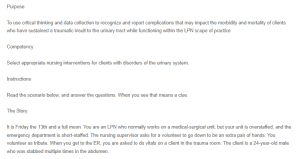Case Study – Renal Trauma
From the data collected in the presented scenario, several observations hint at the possibility of a problem. To begin with, the tachycardia is marked by a heartbeat of 115 beats per minute, a hypotensive situation evidenced by a blood pressure of 95/54mmHg. These are early signs of hypovolemic shock, and this suggests that a problem of bleeding may exist despite having no external bleeding. Secondly, the pale appearance of the patient with cool and clammy skin indicates hypovolemia to the skin. Thirdly, the urine color passed by the patient is different from the normal amber color, which indicates a possible problem with the kidney. In addition to the clues, the pain score of 6/10 accompanied by superficial stab wounds may signify possible internal extensive damage (Melendez Rivera & Anjum, 2022).
The normal color of urine is amber. Changes in this characteristic suggest problems such as dehydration, over-hydration, and other issues associated with the process of urine formation. For instance, the “tea color” of the patient’s urine may suggest the presence of blood in urine, a situation called hematuria (Milani & Jialal, 2023).
This patient, having undergone surgical intervention, needs other interventions that will supplement the surgical towards achieving the normal health status of the individual until full recovery. These interventions include continuous patient monitoring through observation of vital signs and frequent assessments that would help in the timely detection of any changes. Another post-operative intervention would be an ultrasound to assess if hemostasis was achieved. Lastly, fluid therapy could have been started to correct the hypovolemic symptoms.
The licensed practical nurse engages in activities such as vital signs monitoring, basic patient care, medication administration, wound care, sample collection, patient education, and record keeping enshrined in their scope of practice. In this scenario, the LPN was practicing within their scope of practice by noting the changes in the vital signs as well as noting the observable changes in the patient, such as paleness. However, other decisions involving critical decision making is outside their scope of practice (Ernstmeyer & Christman, 2021).
Problems such as bleeding should be treated as medical emergencies which require urgent intervention to stop complications. However, in this scenario where the emergency room was understaffed and busy, it may have delayed the intervention given to the patient and consequently led to the deterioration of the patient due to prolonged bleeding, which may lead to hypovolemia.
References
Ernstmeyer, K., & Christman, E. (2021). Scope of practice. Www.ncbi.nlm.nih.gov; Chippewa Valley Technical College. https://www.ncbi.nlm.nih.gov/books/NBK591808/
Melendez Rivera, J. G., & Anjum, F. (2022, April 27). Hypovolemia. PubMed; StatPearls Publishing. https://www.ncbi.nlm.nih.gov/books/NBK565845/
Milani, D. A. Q., & Jialal, I. (2023, May 1). Urinalysis. PubMed; StatPearls Publishing. https://www.ncbi.nlm.nih.gov/books/NBK557685/
ORDER A PLAGIARISM-FREE PAPER HERE
We’ll write everything from scratch
Question
Purpose
To use critical thinking and data collection to recognize and report complications that may impact the morbidity and mortality of clients who have sustained a traumatic insult to the urinary tract while functioning within the LPN scope of practice

Case Study – Renal Trauma
Competency
Select appropriate nursing interventions for clients with disorders of the urinary system.
Instructions
Read the scenario below, and answer the questions. When you see that means a clue.
The Story
It is Friday the 13th and a full moon. You are an LPN who normally works on a medical-surgical unit, but your unit is overstaffed, and the emergency department is short-staffed. The nursing supervisor asks for a volunteer to go down to be an extra pair of hands. You volunteer as tribute. When you get to the ER, you are asked to do vitals on a client in the trauma room. The client is a 24-year-old male who was stabbed multiple times in the abdomen.
The wounds appear superficial, and the client has been stable thus far. He will be going to a CAT scan as soon as they can fit him in. You approach the client, who appears slightly pale with cool, clammy skin but is alert and talkative. The vital signs are: 97.3 (PO), P= 115, BP= 95/54, Resp rate= 24, Pain= 6/10. You notice the client voided 100 mL tea-colored urine in his urinalysis.
One hour later, the client becomes unconscious. His pulse is now 144, and blood pressure is 70/50. The client is taken to the OR and has a nephrectomy for a very damaged and bleeding right kidney.
Answer the following questions:
What were the clues in the data collection that should have alerted you and the staff that there might be a problem? (5-10 sentences)
Why is the urine “tea-colored?” (one sentence)
What are some other interventions that could have been done? (2-5 sentences)
Was the LPN in this scenario working within the scope of practice for an LPN? Why or why not? (5-10 sentences)
How did the environment of care (busy ER) contribute to the client’s deterioration? (5-10 sentences)

